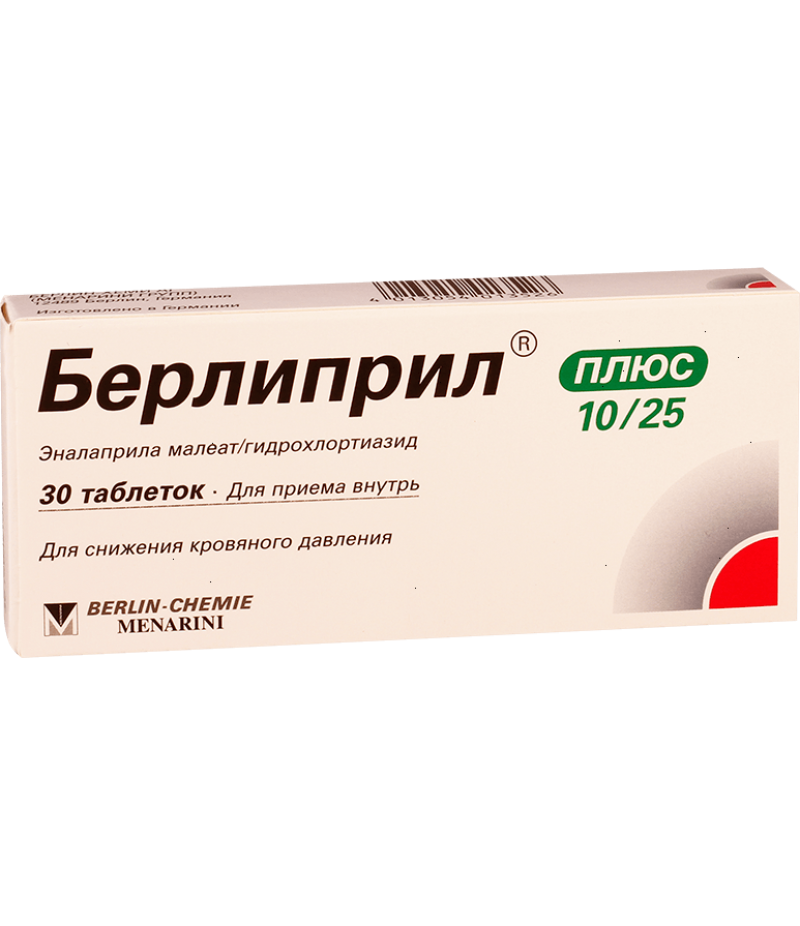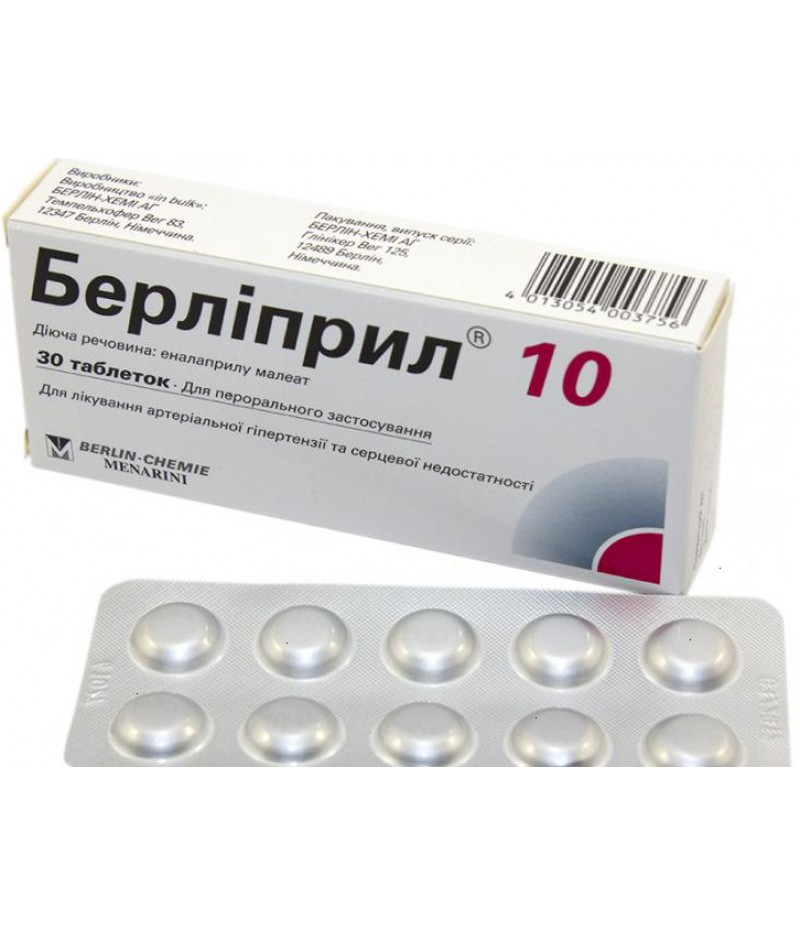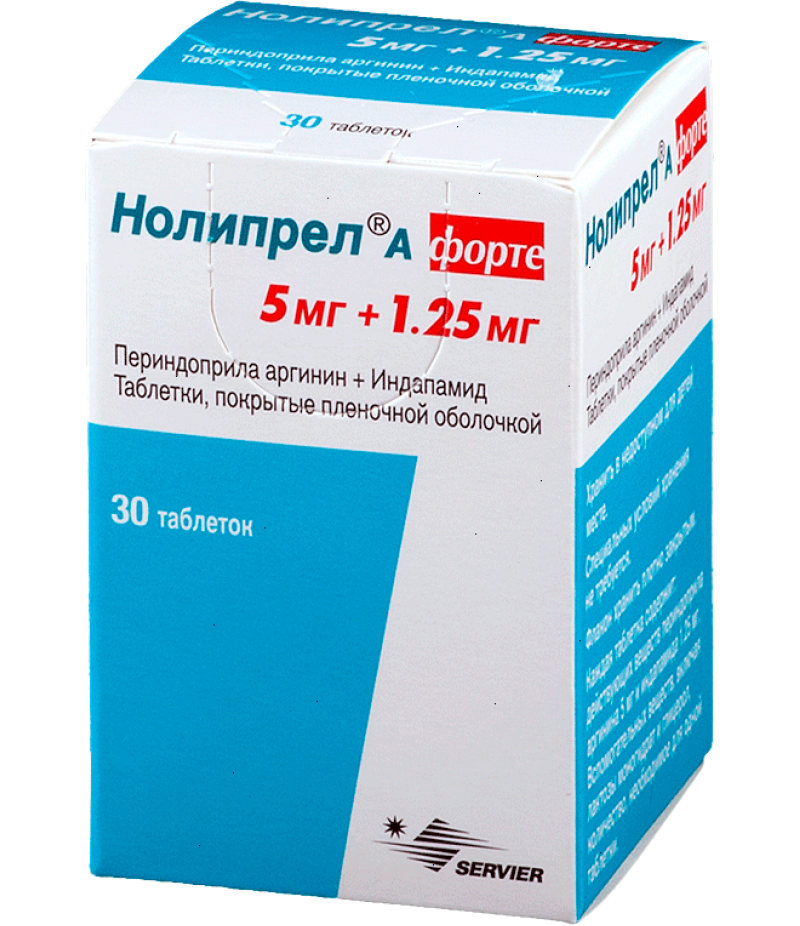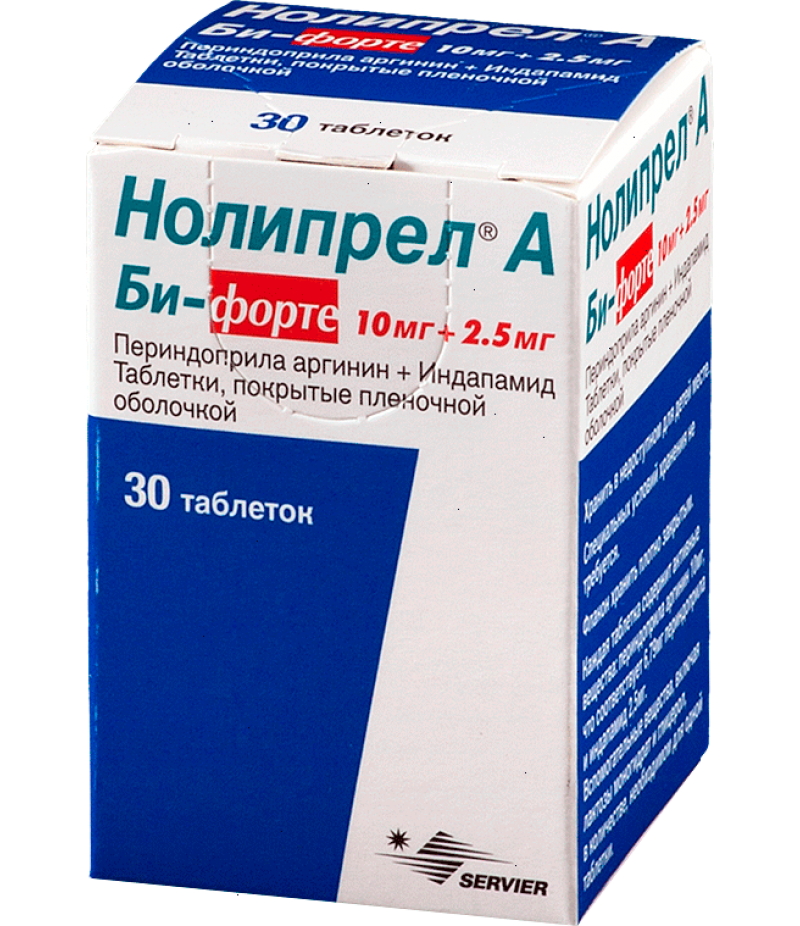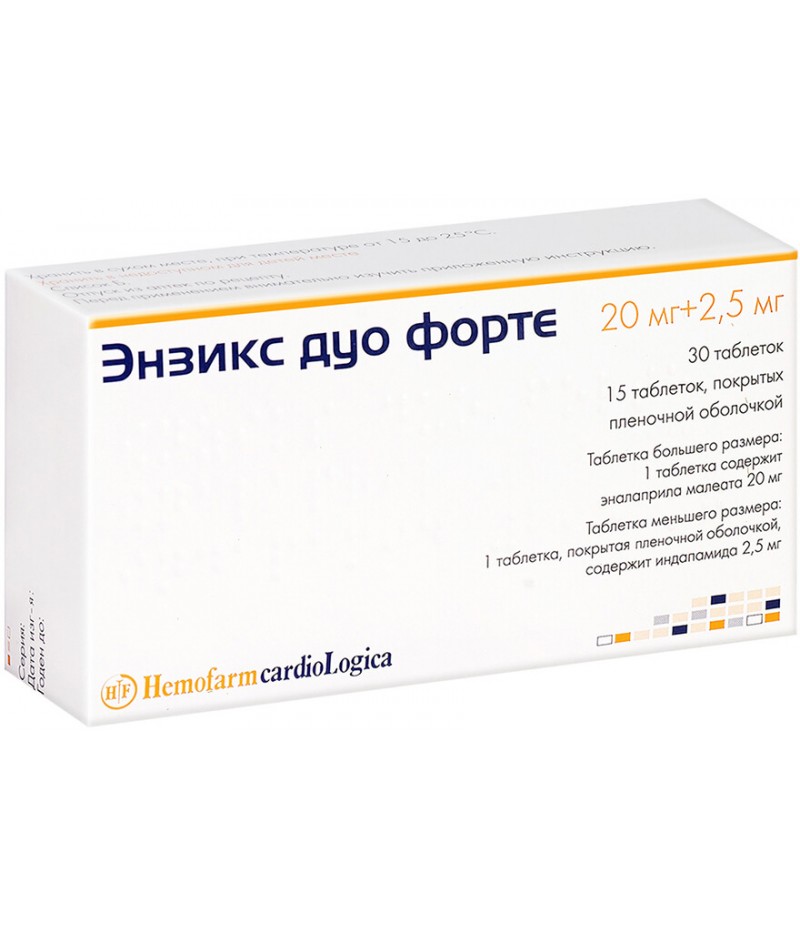Berlipril Plus tabs 25mg + 10mg #30
- $12.76
- 3 or more $12.65
- Availability:In Stock
Berlipril Plus instruction for useYou can buy Berlipril Plus herepharmachologic effectBerlipril Plus is a combination drug consisting of enalapril, an angiotensin-converting enzyme inhibitor (ACE) and hydrochlorothiazide, a thiazi..
Tags: tabs
Berlipril Plus instruction for use
You can buy Berlipril Plus here
pharmachologic effect
Berlipril Plus is a combination drug consisting of enalapril, an angiotensin-converting enzyme inhibitor (ACE) and hydrochlorothiazide, a thiazide diuretic, which potentiate each other's action, and their antihypertensive effect is summed up.
Enalapril
Enalapril inhibits an enzyme that catalyzes the conversion of angiotensin I to angiotensin II, a peptide with vasoconstrictor action, which weakens the vasoconstrictor activity and decreases aldosterone secretion, which can lead to an increase in serum potassium with simultaneous removal of sodium and fluid. The elimination of the negative reverse effect of angiotensin II on renin secretion leads to activation of plasma renin. The mechanism for reducing enalapril blood pressure (BP) is based on the primary inhibition of the activity of the renin-angiotensin-aldosterone system (RAAS). ACE is identical to kininase II, an enzyme that catalyzes the breakdown of bradykinin, a peptide with potential vasodilating action. This plays an additional role in the implementation of the antihypertensive effect of enalapril.
The use of enalapril in patients with arterial hypertension leads to a decrease in blood pressure in both the "standing" and "lying" positions, without a significant increase in heart rate (HR).
Hydrochlorothiazide
Hydrochlorothiazide violates the reabsorption of sodium, chlorine and water in the renal tubules. Increases the excretion of potassium, magnesium, bicarbonates, retains calcium ions in the body. The diuretic effect develops 2 hours after taking hydrochlorothiazide inside, reaches a maximum after 4 hours and lasts up to 12 hours. Reduces the elevated blood pressure.
With the simultaneous use of enapapril and hydrochlorothiazide, there is a decrease in potassium losses associated with the action of diuretic, thereby preventing the development of hypokalemia.
Indications
Essential hypertension grade I-II (for patients who are recommended combination therapy or with insufficient efficacy of enalapril monotherapy).
Contraindications for Berlipril Plus
Hypersensitivity to enalapril or other ACE inhibitors, hydrochlorothiazide, or other sulfonamide derivatives or other components of Berlipril Plus.
Lactase deficiency, hereditary lactose intolerance, glucose-galactose malabsorption syndrome.
Angioedema in history, including the use of ACE inhibitors.
Hereditary and / or idiopathic angioedema.
Patients with myocardial infarction treated by dialysis (the efficacy and safety of Berlipril Plus has not been studied).
Severe liver dysfunction (more than 9 points on the Child-Pugh scale).
Severe renal dysfunction (CC less than 30 ml / min).
Bilateral renal artery stenosis or single kidney artery stenosis (risk of developing renal failure).
Condition after recently transferred kidney transplantation (no experience with Berlipril Plus).
Pregnancy.
Lactation period.
Age up to 18 years (efficacy and safety of the drug have not been established).
Carefully
Violation of water and electrolyte balance, reduction in circulating blood volume (BCC), including diarrhea, vomiting.
Coronary heart disease (CHD).
Severe cerebrovascular diseases, including cerebrovascular insufficiency.
Chronic heart failure.
Severe systemic diseases of the connective tissue, including:
Systemic lupus erythematosus.
Scleroderma.
Inhibition of bone marrow hematopoiesis.
Stenosis of the mouth of the aorta in violation of hemodynamic parameters or other obstacles to the outflow of blood from the left ventricle.
Impaired liver function (less than 9 points on the Child-Pugh scale) due to the risk of developing hepatic coma.
Chronic renal failure (CC more than 30 ml / min).
Patients undergoing hemodialysis treatment.
Primary aldosteronism.
Diabetes.
Diet with restriction of consumption of table salt.
Elderly age.
Hyperkalemia.
Use during pregnancy and lactation
The use of the drug Burlipril plus during pregnancy is not recommended. In the case of planning or diagnosing pregnancy during treatment with Berlipril plus, the drug should be withdrawn as soon as possible.
ACE inhibitors can cause illness or death of the fetus or newborn when used during the second and third trimesters of pregnancy. The use of ACE inhibitors during this period was accompanied by a negative effect on the fetus and newborn, which manifested itself in the form of arterial hypertension, renal failure, hyperkalemia, and / or hypoplasia of the cranial bones. Perhaps the development of oligohydramnios, apparently due to impaired renal function of the fetus. This can lead to contracture of the limbs, deformation of the bones of the skull, including its facial part, and lung hypoplasia.
The use of diuretics during pregnancy is not recommended, as they can cause fetal and newborn jaundice, thrombocytopenia, and possibly other side effects observed in adults.
If Berlipril Plus is used during pregnancy, the patient should be warned of the potential risk to the fetus. In those rare cases where the use of the drug during pregnancy is considered necessary, ultrasound examinations should be performed periodically to assess intraamniotic space. Newborns whose mothers took Berlipril Plus should be carefully monitored for the development of hypertension, oliguria and hyperkalemia. Enalapril, penetrating the placental barrier, can be removed from the blood of the newborn by peritoneal dialysis with some favorable therapeutic effect, and theoretically can be removed by exchange transfusion.
Enalapril and thiazides are excreted in breast milk, so if necessary, their use during lactation breastfeeding at the time of taking the drug Berlipril plus should be discontinued. The relationship between the use of thiazides during lactation and the reduction or even suppression of lactation, hypokalemia, and the occurrence of hypersensitivity to sulfonamide derivatives is also established.
special instructions
Influence on ability to driving of vehicles and control of mechanisms
The effect of Berlipril Plus on the ability to drive vehicles and control mechanisms has not been specifically studied, so during treatment with Berlipril Plus, caution should be exercised when driving vehicles and practicing potentially hazardous activities that require increased concentration and psychomotor speed.
Composition
1 tablet contains:
Active ingredients
Enalapril maleate 10 mg.
Hydrochlorothiazide 25 mg.
Excipients
Lactose monohydrate 139.5 mg, magnesium carbonate 25.0 mg, gelatin 6.0 mg, sodium carboxymethyl starch (type A) 8.5 mg, colloidal silicon dioxide 3.5 mg, magnesium stearate 2.0 mg, iron dye yellow oxide (E 172) 0.5 mg.
Dosage and administration
Berlipril plus tablets are taken orally once a day (in the morning), regardless of the meal, with plenty of fluids.
At the beginning of treatment with Berlipril plus, symptomatic arterial hypotension may develop, which often occurs in patients with impaired water and electrolyte balance due to previous diuretic therapy. Receiving diuretics should be discontinued 2-3 days before the start of therapy with Berlipril plus.
Adults: the recommended dose is 1 tablet of Berlipril plus 1 time per day.
Elderly patients (over 65 years): in elderly patients with normal renal function (QC more than 90 ml / min), no dosage regimen correction is required.
Use in special clinical situations
In patients with QA of more than 30 ml / min, but less than 80 ml / min, Berlipril Plus should be used only after a preliminary selection of the doses of each component.
In severe renal impairment (CC less than 30 ml / min), the use of Berlipril Plus is contraindicated.
Side effects
Possible side effects with the use of the drug Berlipril plus, as in the monotherapy with the active components separately, are listed below in descending frequency of occurrence:
Often -> 1/100,
Infrequently -> 1/1000,
Seldom -> 1/10000,
Very rarely -
There is no correlation between the incidence of side effects and gender or age of patients.
Nervous system disorders
Often - headache, systemic dizziness, fatigue.
Infrequently - drowsiness or insomnia, depression, paresthesia, irritability, confusion, tinnitus, accommodation disturbance, change in taste perception, asthenia.
Violations of the cardiovascular system
Often - a pronounced decrease in blood pressure regardless of the position of the body.
Infrequently - arrhythmias, loss of consciousness.
In some cases - tachycardia, palpitations, stenocardia, chest pain, myocardial infarction, cerebrovascular accident, stroke.
Disturbances of the respiratory system, chest organs
Often - cough (disappears after drug withdrawal).
Infrequently - dyspnea, sinusitis, rhinitis.
In some cases - bronchospasm, stomatitis, glossitis, pulmonary edema, interstitial pneumonia.
Disorders of the gastrointestinal tract / liver and biliary tract
Infrequently - nausea, vomiting, abdominal pain, indigestion, dryness of the oral mucosa, diarrhea, pancreatitis, constipation, flatulence, anorexia.
In some cases - hepatitis and intestinal obstruction.
Very rarely - the development of angioedema of the intestines associated with taking ACE inhibitors, including enalapril, has been reported.
Violations of the skin
Infrequently - pruritus, rash, dry skin.
Rarely - angioedema of the face, extremities, lips, tongue, glottis and / or larynx, increased sweating, photosensitization.
Very rarely - Stevens-Johnson syndrome.
Violations of the musculoskeletal system
Infrequently - muscle cramps and pain.
Kidney and urinary tract disorders
Infrequently - renal dysfunction, renal failure, proteinuria, interstitial nephritis.
Disorders of the genitals and breast
Infrequently - a violation of potency.
Violations by laboratory parameters
Infrequently - hypercholesterolemia, hyperglycemia, hyperlipidemia, hypokalemia, hyperkalemia, hyperuricemia, hyponatremia, chloropenia, hypercalcemia, hypomagnesemia, increased serum creatinine, blood urea and liver function tests, decreased hemoglobin and hematocrit.
Rarely - increased activity of liver transaminases and bilirubin concentration.
Symptom complex - fever, myalgia / myositis, arthralgia / arthritis, vasculitis, serositis, eosinophilia, leukocytosis, increased ESR, positive test for antinuclear antibodies is described.
Drug interaction
Enalapril
Simultaneous use is not recommended.
Potassium-sparing diuretics (spironolactone, triamterene, amiloride) or potassium-containing salts, potassium supplements.
With simultaneous use with ACE inhibitors may develop hyperkalemia. If, due to the diagnosed hypokalemia, simultaneous use of these drugs is shown, they should be used with caution, with regular monitoring of the content of potassium in the blood serum and electrocardiogamma.
Simultaneous use with caution
Thiazide or "loop" diuretics.
Prior treatment with high-dose diuretics may, at the start of enalapril therapy, lead to a decrease in BCC and contribute to the development of arterial hypotension (see Special Instructions section). The hypotensive effect can be reduced if the diuretic is canceled, the rate of fluid or salt in the body is increased, or therapy is started with low doses of enalapril.
Preparations for general anesthesia
When used with ACE inhibitors, Orthostatic hypotension may lead to aggravation.
Narcotic drugs / tricyclic antidepressants / psychotropic drugs / barbiturates
Orthostatic hypotension may occur.
Other antihypertensive drugs (alpha and beta-blockers, slow calcium channel blockers)
The hypotensive effect can be summed up or potentiated. Care is required when treating nitroglycerin in various dosage forms and other nitrates or other vasodilators.
Cimetidine
Increased risk of collapse.
Cyclosporine
With simultaneous use with ACE inhibitors increases the risk of developing impaired renal function.
Allopurinol, procainamide, cytotoxic drugs or immunosuppressants
With simultaneous use with ACE inhibitors, the risk of hypersensitivity reactions, leukopenia, increases.
Hypoglycemic agents
In rare cases, ACE inhibitors can enhance the hypoglycemic effect of insulin and hypoglycemic oral agents (for example, sulfonylurea derivatives) in diabetic patients. In these cases, with the simultaneous use of ACE inhibitors, it may be necessary to reduce the dose of the hypoglycemic agent.
Sympathomimetics
May weaken the hypotensive effect of ACE inhibitors. To confirm the hypotensive effect of such patients should be under close medical supervision.
Antacids
Reduce the bioavailability of ACE inhibitors with simultaneous use.
Auromatilate sodium
When applied simultaneously with the preparation of gold (aurotalmate sodium) in an injection form, the patients were observed: "flush" of blood to the skin of the face, nausea, vomiting, as well as arterial hypotension. Hypotension can be regarded as enhancing the effect of ACE inhibitors under the influence of the gold preparation.
Hydrochlorothiazide
Simultaneous use with caution:
Kolestiramin and Kolestipol
Simultaneous administration of anion exchange drugs reduces the absorption of hydrochlorothiazide. Kolestiramine or colestipol, when taken once, bind hydrochlorothiazide and reduce its absorption from the gastrointestinal tract by 85% and 43%, respectively.
Diuretics derived from sulfonamides should be taken no less than 1 hour before or 4-6 hours after taking these drugs.
Glucocorticosteroids, corticotropin (ACTH), amphotericin B (intravenous), carboxloxon, stimulating laxanthins
When taken simultaneously with hydrochlorothiazide, there may be an increase in electrolyte loss (especially the development of hypokalemia).
Calcium salts
It is possible to increase the concentration of calcium in the blood serum due to a decrease in its elimination while using it with thiazide diuretics.
Cardiac glycosides
Hypokalemia or hypomagnesemia caused by thiazides contribute to the appearance of arrhythmias due to cardiac glycosides.
Drugs that can cause arrhythmia of the "pirouette" type ("pirouette" is a special form of polymorphic ventricular tachycardia with a wave, propeller or vertebrae-shaped configuration of ventricular complexes in combination with an increase or decrease in the amplitude of the teeth of the QRS complex, which can result in ventricular fibrillation or asystole)
Because of the risk of hypokalemia, caution is required with the simultaneous use of hydrochlorothiazide with some antiarrhythmic, antipsychotic (neuroleptics) and other drugs that are known to cause pirouette-type arrhythmia.
Amines with a vasoconstrictor action (epinephrine)
A reduction in the reaction to vasoconstrictor amines is possible, although not so pronounced as to exclude their use with hydrochlorothiazide.
Muscle relaxants of non-depolarizing type (tubocurarine chloride)
May increase sensitivity to muscle relaxants when used in conjunction with hydrochlorothiazide.
Amantadine
Thiazides may increase the risk of side effects of amantadine.
Anti-gouty drugs (probenecid, sulfinpyrazon, allopurinol)
It may be necessary to adjust the dose of the hypouricemic drug (increasing the dose of probenecid or sulfinpyrazone), since hydrochlorothiazide may increase the concentration of uric acid in the blood serum.
Simultaneous use with thiazide diuretics can increase the frequency of hypersensitivity reactions to allopurinol.
Other types of interaction:
Laboratory values
Because of the effect on calcium metabolism, thiazides may distort the result of the study of the function of the parathyroid glands.
Enalapril / Hydrochlorothiazide in combination
Simultaneous acceptance is not recommended.
Lithium
Simultaneous use with thiazide diuretics can increase the already increased risk of lithium intoxication due to ACE inhibitors, so the combined use of the drug Berlipril plus lithium preparations is not recommended. If such a combination is still necessary, then careful control of the concentration of lithium in the serum is also necessary.
Laboratory values
Thiazides can reduce the level of iodine associated with protein without causing the appearance of symptoms of dysfunction of the thyroid gland.
Simultaneous use with caution:
Non-steroidal anti-inflammatory drugs (NSAIDs) (including acetylsalicylic acid at a dose of 3 g / day, including cyclooxygenase-2 (COX-2) inhibitors)
The use of NSAIDs may weaken the hypotensive effect of ACE inhibitors and diuretics. In addition, there are reports that the effects of NSAIDs and ACE inhibitors, increasing the serum potassium content, can be added up, while the kidney function may decrease. The corresponding effects are reversible and develop in patients with existing impaired renal function. In rare cases, acute renal failure may develop - primarily in patients with impaired renal function (elderly or dehydrated patients).
Ethanol
Enhances the hypotensive effect of ACE inhibitors and hydrochlorothiazide.
Trimethoprim
Concurrent use with ACE inhibitors and thiazides increases the risk of hypercalcemia.
Overdose
Symptoms: marked reduction in blood pressure, shock, stupor, bradycardia, impaired water and electrolyte balance and renal failure.
The most common symptoms of a hydrochlorothiazide overdose are nausea and drowsiness. An overdose of hydrochlorothiazide is associated with a loss of electrolytes (hypokalemia, hypochloraemia) and dehydration (due to an increase in diuresis). Hypokalemia can lead to muscle cramps and / or while taking cardiac glycosides or antiarrhythmic drugs to aggravate the course of arrhythmias due to hypokalemia.
Treatment: is symptomatic and supportive. Strict medical supervision is required, preferably in an intensive care unit / ward. Regular monitoring of serum electrolytes and creatinine is necessary.
Therapeutic measures depend on the nature and severity of the symptoms. Within 30 minutes after taking Berlipril Plus, you can take measures to prevent its absorption from the gastrointestinal tract (gastric lavage, the use of adsorbents and sodium sulfate).
With a marked decrease in blood pressure, the patient should be given a horizontal position with the legs elevated; resolve the issue of using drugs that increase the BCC (intravenous infusion of 0.9% sodium chloride solution). Effective administration of angiotensin II.
Bradycardia or vagal reactions should be eliminated with atropine; It is possible to use an artificial pacemaker.
Enalaprilat can be removed from the systemic circulation by hemodialysis.
ACE inhibitors are amenable to dialysis, however, the use of high-flow polyacrylonitrile membranes should be avoided (see Special Instructions section).
Storage conditions
Store at a temperature not higher than 30 ° C.
Shelf life - 3 years.
Active substance
Hydrochlorothiazide, Enalapril
Terms of sell
You don't need a prescription to buy Berlipril Plus.

